How Much Food Dyes are in Powerade?
Honestly, I do not understand why so many Americans keep buying soft drinks like Gatorade and Powerade which look so obviously unhealthy liquids to me. One explanation is that they do not read the ingredient lists or perhaps do not understand what some ingredients can do to their bodies. On the other hand, this is a good example of how marketing practices of The Coca-Cola Company aimed to maximize profits, destroy the future of this country by undermining psychic and physical health of millions of young Americans (see: Food marketing to children and youth overview).
Every Powerade container declares that it “helps replenish 4 electrolytes lost in sweat.” What they don’t tell you is that the amount of potassium in the bottle is so low that you will have to drink 6 gallons of Powerade (Gatorade too) to replenish your daily potassium. Neither do they tell you how much food dyes (see the CSPI file: Food Dyes: A Rainbow of Risks) nor other food additives do you get. Not to worry, here is what the DyeDiet has dug out for you:
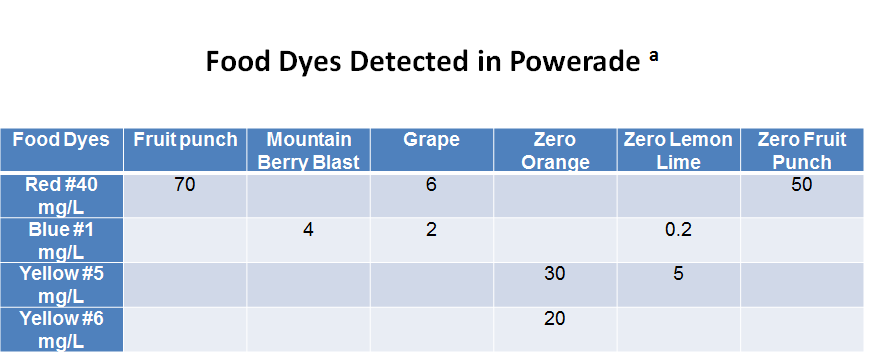 a Concentrations were calculated based on Beer-Lambert Law application to our spectrophotometry studies
a Concentrations were calculated based on Beer-Lambert Law application to our spectrophotometry studies
As you can see from the chart, the amounts of the food colors are similar to those we have found in Gatorade. Red 40 food dye is the most abundant in the both Powerade and Gatorade. I wonder how many of those who drink Powerade clearly realize that these liquids are only imitations of fruit beverages and have nothing to do with the natural fruits.
Let us take a look at Powerade Fruit Punch to begin with.
Powerade Fruit Punch Risk Score, DDRS ~ 75
Foreign additive risk DDFI = 25/20 ~ 1.3. Nutritional value DDNF = 20/55 ~ 0.4.
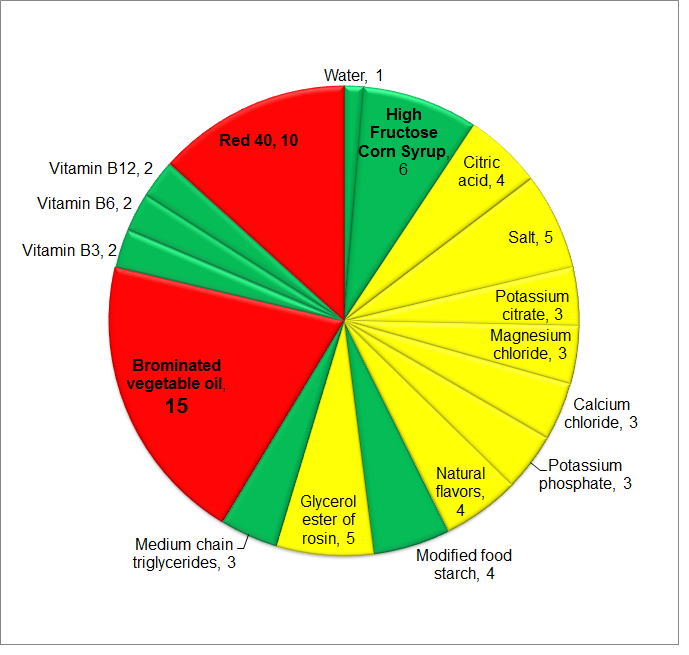 Some of the food additives in this sports drink deserve to be considered in more detail.
Some of the food additives in this sports drink deserve to be considered in more detail.
EDTA is a “chelating” agent which tightly binds heavy metals like zinc, chromium and, by the way, your electrolytes especially as to magnesium and calcium. They have added EDTA to protect their synthetic color, not you. See a file of the Environmental Protection Agency: EDTA toxic effects. For EDTA safety read Section 11 of the MSDS.
Brominated vegetable oil (BVO). According to Wikipedia: A similar case reported that a man who consumed two to four liters of a cola containing BVO on a daily basis experienced memory loss, tremors, fatigue, loss of muscle coordination, headache, ptosis of the right eyelid as well as elevated serum chloride. In the two months it took to correctly diagnose the problem the patient also lost the ability to walk. Eventually bromism was diagnosed and hemodialysis was prescribed which resulted in a reversal of the disorder.
FDA regulation: Brominated vegetable oil – STAB, INTERM/REG, <15 ppm – In fruit flavored beverages where not precluded by a standard – 180.30.
Thus BVO content in beverages should not exceed ~ 15 mg/L. Hence in the above case a person who drunk 2 – 4 L of cola containing BVO a day might have consumed 30 to 60 mg of BVO daily to get heavily intoxicated. In 1972, the FDA designed a special transitional category for food-use substances, Interim food additives, whose safety has been called into question. Brominated vegetable oil terrorizes the human body in a number of ways:
- Mimics natural triglycerides when passing onboard of your body with a concealed bromine “bomb”
- When inside, after broken down with pancreatic lipase to monoglycerides and the brominated fatty acids, toxic pieces are built into the tissue cells all over your body leading to degradation of muscles, liver, kidneys, heart and brain. See attached file: Toxic Effects of Brominated Vegetable Oils.
- Slowly releases bromide to the blood stream causing further CNS damage and behavioral issues.
For all the above reasons the DyeDiet considers BVO food additive as more dangerous than the azo dyes and assigns to it the highest risk factor DDRF =15 (see the red segment in the above DyeDiet “Dyegram.”
Mountain Berry Blast Risk Score, DDRS ~ 65
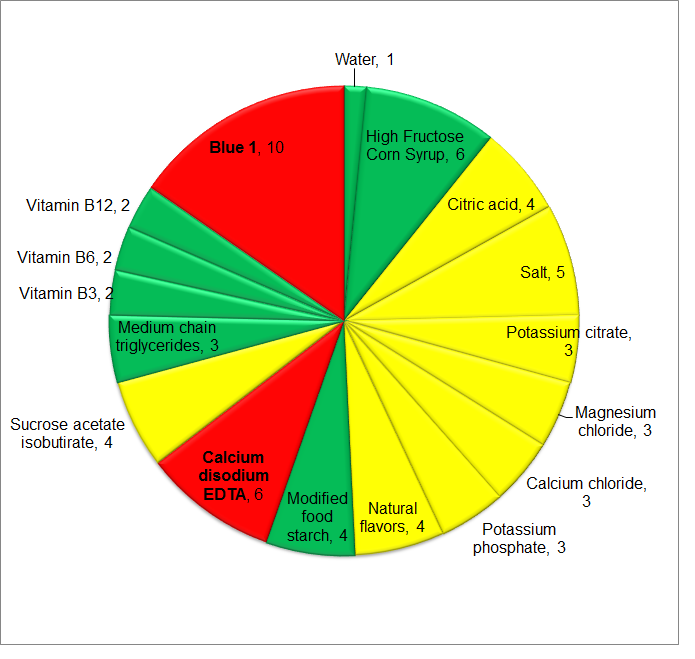 Foreign additive risk DDFI = 16/20 ~ 0.8. Nutritional value DDNF = 20/45 ~ 0.4. Note, this one has the lowest DDFI because it contains only 2 foreign additives (red segments) of 16 units, lowest in the six drinks.
Foreign additive risk DDFI = 16/20 ~ 0.8. Nutritional value DDNF = 20/45 ~ 0.4. Note, this one has the lowest DDFI because it contains only 2 foreign additives (red segments) of 16 units, lowest in the six drinks.
Powerade Grape Risk Score, DDRS ~ 66
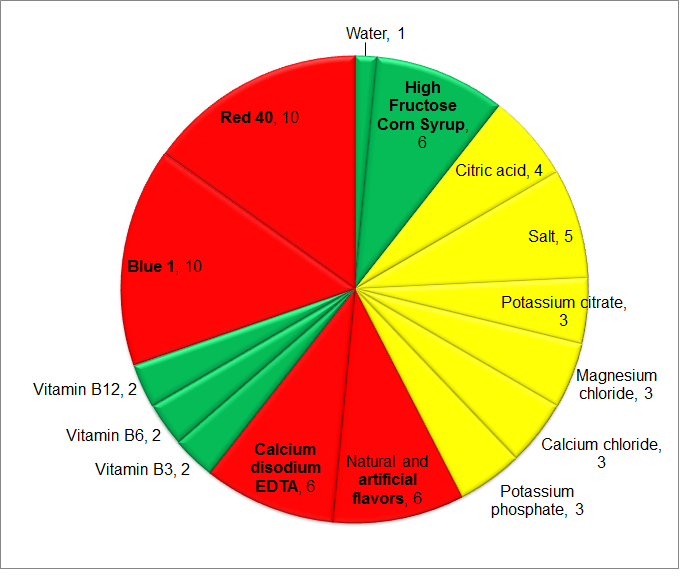 Foreign additive risk DDFI = 32/13 ~ 2.5. Nutritional value DDNF = 13/53 ~ 0.2
Foreign additive risk DDFI = 32/13 ~ 2.5. Nutritional value DDNF = 13/53 ~ 0.2
Powerade ZERO
Let us make it clear; there is NO difference in composition between Zero Orange, Zero Lemon-Lime and Zero Fruit Punch: they all are the same. I assume they were dispensed from the same tank. What makes them look differently is a combination of the synthetic food dyes added.
Zero Orange Risk Score, DDRS ~ 62
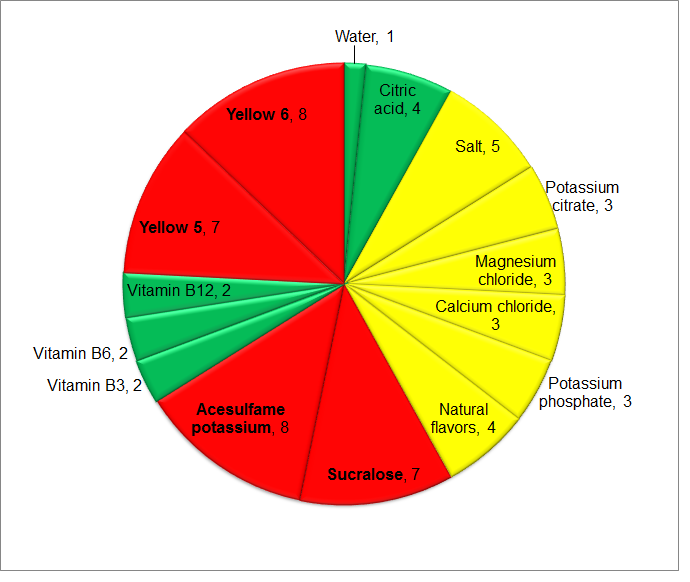 Foreign additive risk DDFI = 30/11 ~ 2.7. Nutritional value DDNF = 11/51 ~ 0.2
Foreign additive risk DDFI = 30/11 ~ 2.7. Nutritional value DDNF = 11/51 ~ 0.2
Zero Lemon Lime Risk Score, DDRS ~ 64
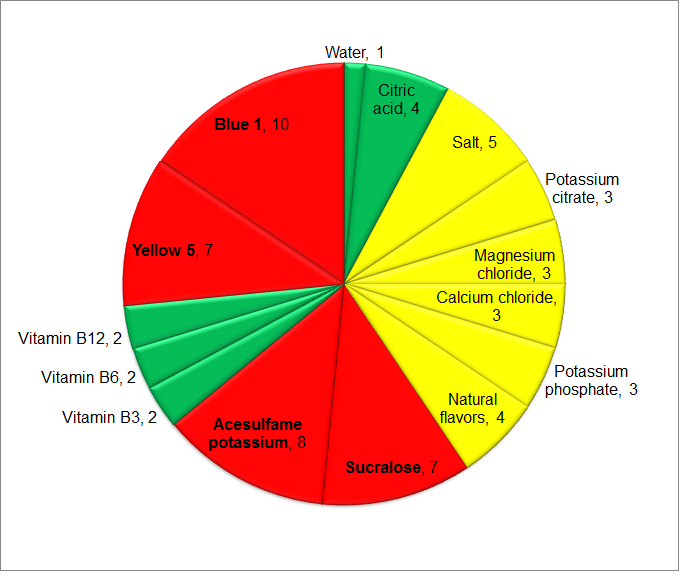 Foreign additive risk DDFI = 32/11 ~ 2.9. Nutritional value DDNF = 11/53 ~ 0.2
Foreign additive risk DDFI = 32/11 ~ 2.9. Nutritional value DDNF = 11/53 ~ 0.2
Zero Fruit Punch Risk Score, DDRS ~ 57
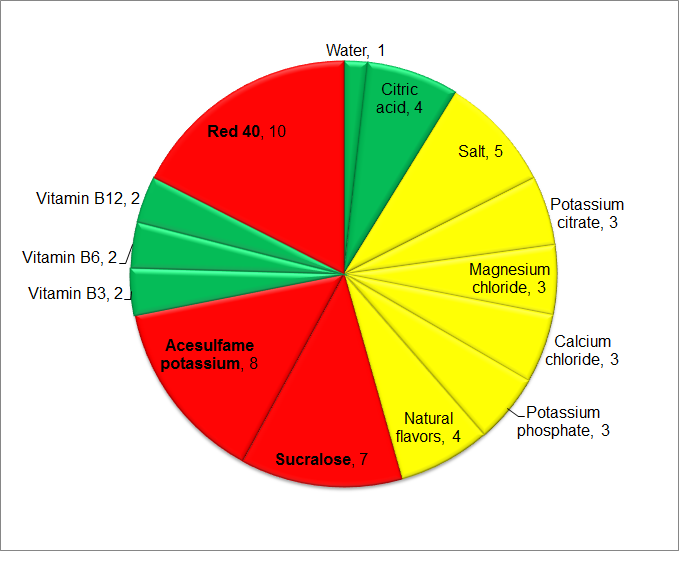 Foreign additive risk DDFI = 25/11 ~ 2.3. Nutritional value DDNF = 11/46 ~ 0.2
Foreign additive risk DDFI = 25/11 ~ 2.3. Nutritional value DDNF = 11/46 ~ 0.2
Please note that it would be very easy for the Coca-Cola Co. to convert their Powerade to a healthy beverage. They would only need to remove all the foreign food additives (red segments – anti-nutrients) or replace them with healthy alternatives. That would cost them some of their profit margin but the gauge of the National Health would start climbing up. They will never do anything good for us unless we, the customers, stop buying their unhealthy products. For now SmartWater and VitaminWater of Glaceau are much better choices!
Category: Soft drinks, Sports drinks

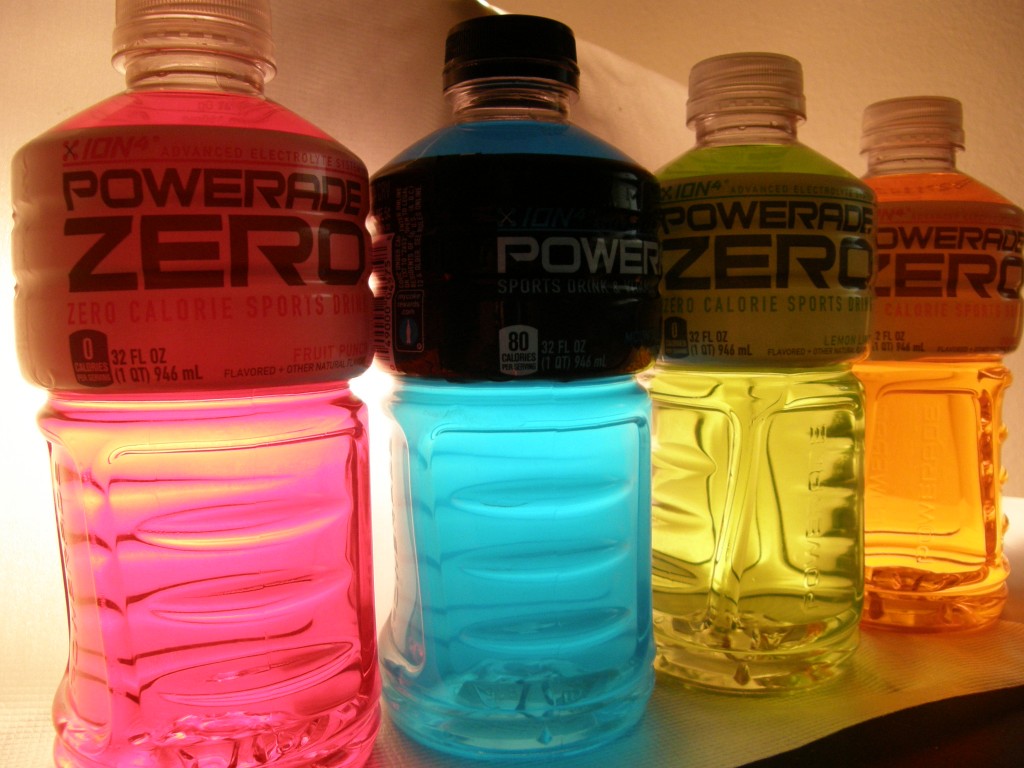
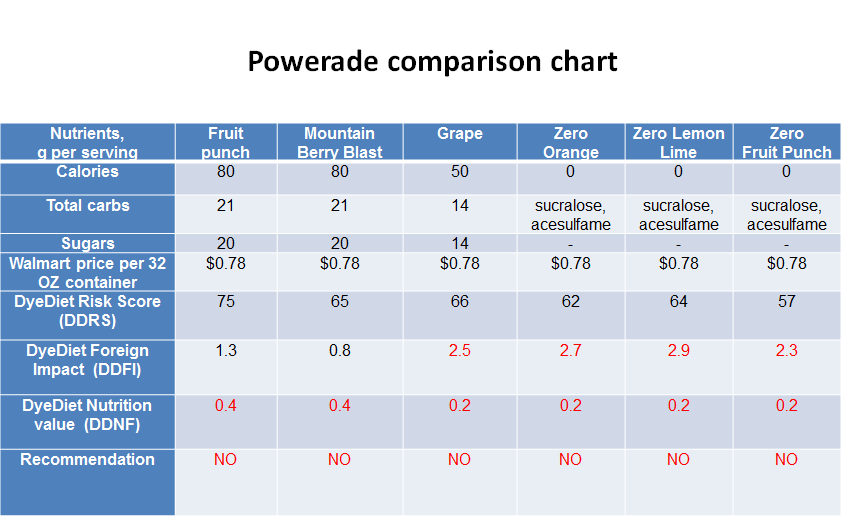




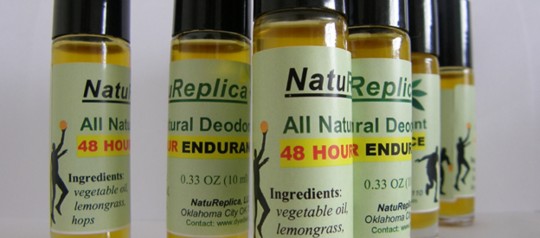
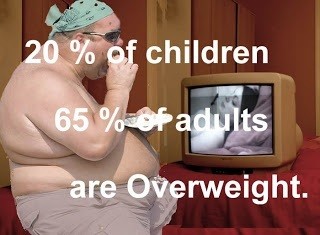
the coca-cola co. is undermining the health of our people.
What do the numbers on the pie charts mean?
Those are nutritional factors (for the greens) and risk factors for the non-nutritional additives (yellow and red) assigned based upon their chemical structures and toxicology data.
Great article – apart from the part where you say “…Glaceau are much better choices!” really?? Glaceau are owned by Coca-cola. It has less sugar than other coke drinks, but not that much less. And they come in some very bright colours.
I’d like to see the same dye and other antinutrient analysis of Glaceau products as you’ve done here. I doubt they are much better than Powerade et al.
Thank you for your comment! No matter who owns what, our judgement is based on the ingredient lists. As a matter of fact, Coca-Cola and other giant monsters often acquire good companies that produce human-friendly products. Then it takes some time for the Coca-Cola to turn the product to useless or toxic junk. Following your request, I will certainly analyze one of Glaceau drinks soon.
Powerade doesn’t have brominated vegetable oil anymore
Ironically my favorite one (Mountain Berry Blast) has the least DDFI.
why
dyes can kill you don’t eat or drink things that have any kind of dye in it.
Good advice! Even if dyes do not kill immediately, why take chances if there is always (at least so far…) a healthier choice?
DyeDiet, I would like to know what the ideal composition of minerals/ingredients would be in a healthy drink to properly replace what is depleted in the body during intense workouts. Is there something I can buy in a packet that I can add to a water container? Thank you.
Dear Bill, In my opinion, mineral water would be best choice. Right food is also critical factor.